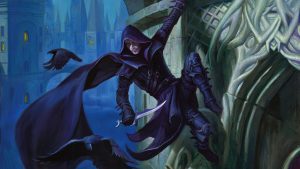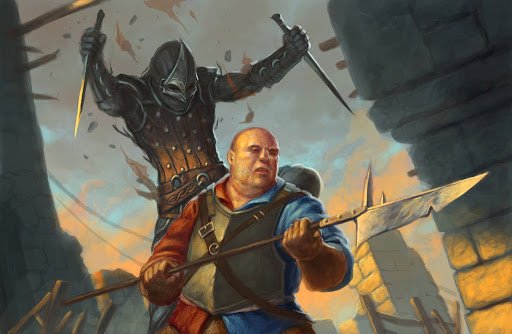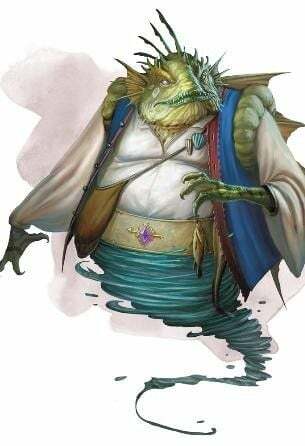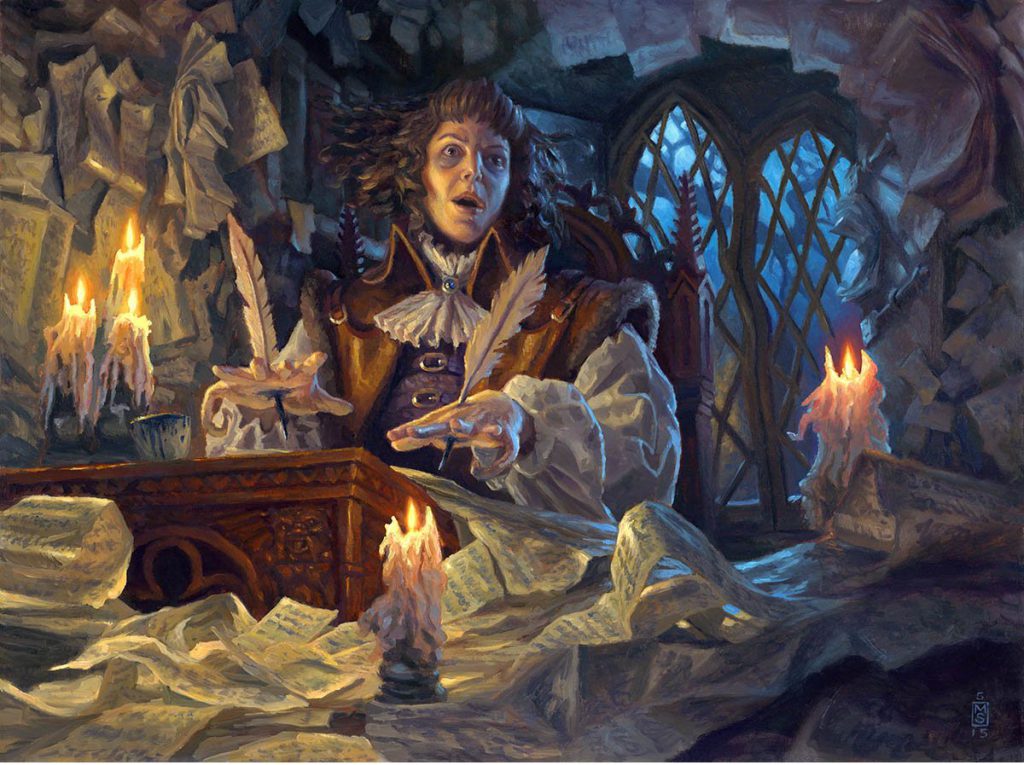Last week we were given the Subclasses Revisited Unearthed Arcana. In that article Wizards of the Coast designers decided to give a second look at three different subclasses they have released somewhat recently and giving them new life with the introduction of the Phantom roguish archetype, the Genie patron warlock, and the Order of Scribes wizard. Each one of these new subclass playtest options shows a serious re-working of all three choices with new and interesting abilities.
Table of Contents
Proficiency Bonus Based Restrictions
Majority of the time the articles released as Unearthed Arcana are going to share some sort of common theme. It can be anything from the flavoring of the origin of the material to a game mechanic. In my last UA breakdown, Psionics Revisited: Quite an Improvement, I pointed out that this took the form of the Psionic Talent die that was introduced. This time around our three subclasses that we have been graciously gifted all play around with using one’s proficiency bonus to determine usage limits on abilities. For example, you will see a few abilities mentioned that can be used a number of times equal to the character’s proficiency bonus, regaining all expended uses after a long rest. For the most part, each subclass here dabbles in using that same sentiment on some abilities. Some of them though, decide to use this form of restriction in more interesting ways. I’ll detail those down below.

Rogue
Subclasses Revisited: The Phantom
Original UA: The Revived
The original roguish archetype, the Revived, was presented to us back in October and focuses on a rogue’s close connection with death. The Phantom still has the same idea but paints it in a very different light. Where the Revived draws on powers from a previous life, the Phantom forms a mystical connection with death and uses the negative energy of the cosmos to master skills and overcome enemies. The first ability granted at 3rd-level is exactly the same as it was before which is good. You are still able to learn a new skill or tool proficiency after finishing a long rest, but that is where the similarities end. Their other 3rd-level ability, Wails from the Grave, allows you to deal half the number of your Sneak Attack dice as bonus psychic damage against a target that is near a target you deal Sneak Attack damage to, no attack roll or saving throw needed! This is a cool ability and a great way to improve on the original Bolts from the Grave which was basically a pity chance for you to do some damage on a turn that you aren’t able to land a hit using your Sneak Attack damage.
At 9th-Level, the Phantom gains the ability to create Tokens of the Departed by trapping a sliver of the life essence of a creature that dies and turning it into a trinket. While you have the trinket on your person it grants you advantage on Constitution and death saving throws.You can have a number of trinkets equal to your proficiency bonus and can destroy for an action, no matter where it is located, to ask the spirit within a question. This ability is quite thematic and offers lots of room for DMs to get creative with story elements. This is also a much more interesting way for them to interact with the dead than just recalling lost memories to gain the spell speak with dead and a random proficiency like the Revived did at this level.

The Phantom really earns its name when it gains the ability to Ghost Walk at 13th-level. As a bonus action, they take a spectral form, for up to 10 minutes, and have a flying speed of 10 feet and can hover, while also imposing disadvantage upon anyone trying to attack you. This is certainly way more fun than the Audience of Death feature that the Revived gets at this level, which allows you to ask an entity of death a “yes” or “no” question anytime you make a death saving throw and being able to change any of your personal characteristics, trait, ideal, bond, or flaw, anytime you are stabilized or healed after being reduced to 0 HP. Even though the rather limiting fly speed of only 10 feet leaves something to be desired, this can absolutely be worked around. Especially if your DM allows the use of the Class Feature Variants UA that was released in November. A ghost walking rogue making use of the Aim action could prove to be a rather troublesome foe.
The Ethereal Jaunt feature that the Revived rogue gets was my least favorite part of that subclass. Being able to teleport 30 feet as a bonus action is great, but for a 17th-level ability it left me wanting something more. The Phantom rogue’s Death Knell instead lets them hit quite a bit harder by improving upon the 3rd-level feature Wails from the Grave. Death Knell allows you to now roll the bonus psychic damage dealt by Wails from the Grave to the initial target receiving the Sneak Attack damage, now allowing you to essentially double the amount of your original Sneak Attack damage you deal on a turn. At 17th-level when this ability is gained that is a significant amount of damage.
To me the Phantom roguish archetype is an improvement from the Revived. It hits harder and, in my opinion, has features that would be more fun for a player looking for interesting role-playing opportunities. I like the versatility that the Revived offers with its abundance of proficiency swapping and trait changing, but the Phantom is more well-rounded and interesting overall.

Warlock
Subclasses Revisited: The Genie
Original UA: The Noble Genie
These two variations are still focused on the same loose concept. The genie’s vessel. An item of some kind that the genie is bonded to and can reside in. However, once you get past that similarity, these subclasses couldn’t be more different. Right off the bat at 1st-level, they both get an expanded spell list but the lists are very different. The Noble Genie gets a list of ten spells while the updated Genie gets a list of eleven spells, six from a general list and then an additional 5 from a list dependent on which kind of genie your patron is. Each of the lists is based on the element of the corresponding genie, Dao(Earth), Djinni(Air), Efreeti(Fire), and Marid(Water). Already a much more interesting way to curate the expanded spell list and also give you more of a connection to your patron instead of you just being assigned “some powerful genie”. Each of these warlocks also gains their vessel feature at 1st-level. You get to choose what your vessel looks like and can use it to do a couple of different things. The first is that you can use it as a resting place. You can use an action to enter your vessel, the interior of which is comfortable and lined with cushions and low tables. You can remain inside for a number of hours equal to your proficiency bonus and can hear the space around your vessel as if you were in that space. You can even store things inside your space for later but you can only enter your vessel once per long rest. You can also use it to deal bonus damage equal to your proficiency bonus once per turn when you hit with an attack, and the damage dealt is based on what kind of genie your patron is. I think these are two really cool abilities for this subclass that can add some very fun story elements to a game. The original Noble Genie was able to use their vessel to tether themselves to another individual. While tethered they gain a bonus to Perception checks equal to their Charisma modifier, and they could also decide to cast spells from their location or the location of the individual they are tethered to. Though I will not deny that being able to cast spells from someone else’s position is a very cool ability, It doesn’t really speak genie to me.

At 6th-level the Noble Genie was granted Elemental Resistance, which they could use to choose from acid, cold, fire, or lightning, and gain resistance to that type of damage for the day and then make the choice again whenever they finish a long rest. Also whenever they are tethered with another creature this creature also gains that resistance. Not bad, but the Elemental Gift that the updated Genie gets is a bit more interesting. They too gain resistance to a damage type, but it is dependent on what kind of genie their patron is. You can also use a bonus action to gain a flying speed of 30 feet that lasts for 10 minutes, which you can do a number of times equal to your proficiency bonus. Excuse me?! Super good!
The Noble Genie, at 10th-level, gains two different features while the newer version only gets one. The first feature it gains is used to protect its tethered creature by being able use their reaction to teleport and swap places if the tethered creature, or themselves, are hit by an attack, changing the target that takes the damage. They also gain a feature that allows them to send a creature in range to their patrons’ court where they are stunned and mocked by your patron for 1 minute. They may make a save at the end of each of its turns to attempt to come back, but if they are not successful and remain gone for 1 minute, they return and you regain the use of the feature. Otherwise, you would have to finish a long rest to do so again. It’s like a weaker use of the banishment spell, which by the time they gain this feature at 10th-level, a warlock has already been capable of casting for three levels. The Genie version gains the ability to use their vessel as a sanctuary, now allowing you and up to five other creatures to enter the vessel and gain the benefits of a short rest after only 10 minutes, and anyone may add your proficiency bonus to the number of any HP regained from hit dice. This feature isn’t combat focused but is helpful in so many other cool ways. It’s like an improved casting of catnap that even elves can benefit from!

The last feature the Genie gets is a limited use of the wish spell. They can use it to cast any spell of 6th-level or lower with a casting time of 1 action, the spell can be from any class’s spell list, you don’t have to meet any of the casting requirements for it, and you can’t use the feature again for 1d4 days. I think this a great feature and is very well tailored for the flavoring and the feeling of the subclass, while adequately improving upon the 14th-level feature of the Noble Genie, Collector’s Call. This feature was able to do a few things, all of which can be accomplished through the use of the Genie’s Limited Wish. The main difference is that the Noble Genie was able to sacrifice at least 500 GP worth of treasure, and perform a 1 minute ritual to their patron, to regain the use of it.
The Noble Genie was an ok start that led to an overall fun and awesome class with the update to the Genie warlock. It now feels not only more like what having a genie patron would, but it also gives you room to build more of a relationship or connection with them, whether that be good or bad is up to you.

Wizard
Subclasses Revisited: Order of Scribes Wizard
Original UA: Archivist Artificer
As you can see wizard was not the first choice for this subclass. At first it was an attempt at an artificer subclass. The idea of it was interesting, having a consciousness you can awaken and use for different things, but I think they tried to do too much with it. To me, the class did not read easily and seemed like the numerous options it offered could be a lot for a player to remember and potentially bog down gameplay. The transition they made with this into the wizard class is much more streamlined, and for me, has a theme that is more enjoyable and fun.
The Archivist begins to get bogged down immediately upon choosing this subclass, with three different features being granted at 3rd-level. These features give them proficiency with calligrapher’s supplies and forgery kits as well as the respective kits for free, the ability to craft scrolls at reduced resource costs, a list of spells you always have prepared, and the Artificial Mind, which is the basis of the class, and in my opinion, where it failed from the start. This third feature just tried to do too much. It allowed you to awaken a mind inside of an item which you could use for a number of things. While you have it on your person you gain proficiency in two skills determined by what material the item is made from. You can use a bonus action to manifest this mind into a spectral form that sheds dim light. As an action you can hear and see using its senses instead of your own, or to cast a spell from its location, with its senses, instead of yours. You can also use it to attack someone with psychic damage that you are given the option to increase by dumping a spell slot into. This artificer got to Paladin Smite! The wizard class only starts off with two features but their archetypes kick in at 2nd-level. First they get a magic quill that doesn’t require ink, and halves the time and gold needed to transcribe spells into your spellbook. Then they get their Awakened Spellbook. Once awakened, this wizard can use their spellbook as a spellcasting focus, can change the damage type of their spells to a different damage type from a spell that is in their spellbook, and they can cast a ritual spell at its normal casting time, instead of 10 minutes. It’s not quite as out there as the Archivist but it makes more sense and doesn’t feel forced.
At 6th-level the Archivist is able to use their artificial mind to do even more things. They can now communicate telepathically with anyone who carries an item that has one of their artificer infusions, and you get a bonus when you deal psychic damage that is equal to your Intelligence modifier. The Mind Network is a pretty decent feature, but again, it is just adding more things to a class that already has a lot going on and the abilities don’t seem super synergistic. Instead of working together they seem to just kind of pile on more and more small things that you can do. The wizard however, becomes a Master Scrivener at 6th-level. Now they can create a new spell scroll of 2nd level or lower, as long as the spell is in their spellbook, that only they can use and once on the scroll casts at a level higher than it was written as. The feature also makes them adept at crafting spell scrolls, requiring only half of the amount of time and gold it costs to do so, as long as they use their Wizardly Quill. Telepathic communication is a very useful tool, I can’t deny that, especially when it can cross planar boundaries. I do also like that a wizard can just build up an arsenal of spell scrolls over time and just sit on a pile of free spells. As I said earlier, these subclasses are very different.

The Order of Scribes wizard gets its next feature at 10th-level while the Archivist waits for its last feature at 14th-level. Now, the wizard gains the Manifest Mind ability that the Archivist got much earlier. As you manifest the consciousness of your spellbook, it manifests in basically the same ways, except this wizard doesn’t get to paladin smite and they don’t continue to stack a bunch of other small abilities on to it. It is also given HP and has your AC so it can be destroyed to end the effect early. I really like the idea of extracting the consciousness of your spellbook and being able to interact with it. That could also be great fuel for a DM to have a lot of fun with roleplaying moments.
14th-level gives us both of the final features for these subclasses. The Archivist can use theirs to cause a save to be made when they use their artificer smite, stunning their target on a failure. They can also use it to teleport to a space next to their spectral mind or an item with one of their infusions. I think a stunning smite would be great for a paladin, but I don’t think it fits in this class. The wizard’s final feature also allows you to teleport, but this time it is to swap places with the spectral mind of your spellbook while it is manifested, and you can do so a number of times equal to your proficiency bonus. This feature goes one step further though with the addition of one more very interesting aspect. If you die, and have at least one spell in your Awakened Spellbook, you can return to life with 1 HP 1 minute later. Here is the catch, once you do so, roll 3d6. You must remove a number of spells from your book that have a combined spell level of the number you rolled. So, if you roll a 10, you would need to remove a 5th-level, 3rd-level, and 2nd-level spell, or some other similar combination. Once these spells are removed from your spellbook you are incapable of re-learning them, unless you use a wish spell to do so. Even then, the wish spell will only allow you to re-learn one spell at a time. I think this is a cool way to represent the connection that a wizard has to their spellbook, and like I have already said, can be used to explore some great storylines.
All of these subclasses have gone through quite a bit of construction to get where they are now. I really look forward to seeing if they do anything more with these classes. I have never really been overly drawn to the wizard class as it is, but the Order of Scribes ended up being my favorite part of this UA and I would actually like to get a chance to take it for a spin. If you have any thoughts or comments on these subclasses let us know below. We would love to hear what you think!
